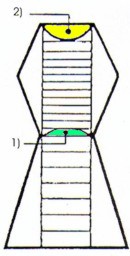Space, although fundamentally unitary, is often described in terms of two categories:
1) 2) |
- that which is occupied by other substances and
- that which is not.
-
- These are designated as "space having worlds" (loka-akasa) and
- "space without worlds" (aloka-akasa), respectively.
The loka-akasa, which is equivalent to the manifest universe, has the outline of a man standing with arms akimbo and legs apart.
All cases of jiva, pudgala, dharma, and kala are said to occur within, or rather define the limits of, this three-dimensional shape.
Unoccupied space, on the other hand, is infinite and totally empty. These "types" of space are of course continuous; the division between them indicates only the finite range of the other existents.
The distinguishing quality of space is its ability to provide a locus for such existents; this is true whether it actually does so (as in the case of loka-aksa) or not (as in the case of aloka-akasa).
Hence there is only one "space"; its extent is infinite.
Akasa is further described as divisible into infinitesimally small "space-points" (pradesa); these units have some dimension and yet cannot be subdivided.
| Basham's note on pradesa:
It is a sort of atom of space, perhaps comparable to the point in the Gaussian system of geometry used by Einstein. The paradoxical 'dimensional point' is perhaps as good a translation of this difficult term as any other.” Basham 1958: 77, n. 3. Souls, dharma, adharma. and the loka-akasa are said to possess uncountable (asamkhyata) pradesas and hence are called asti-kya (having a body, i.e.. an extension). |
In such terms occupied space may be said to have a finite (though uncountable [asam-khyata]) number of space-points, while unoccupied space has an infinity thereof.
Again, the distinction is a conventional one; the unity of space taken as a whole must of course possess an infinite number of pradesas.
The principles of motion (dharma-dravya) and rest (adharma-dravya) seem to be unique to Jaina philosophy.
Certain scholars have made the reasonable suggestion that these principles are traceable to an ancient notion of fluids flowing through the universe (compare Vedic rta and dharma).
| See Schubring: 1962: §10 |
Others relate dharma and adharma respectively to the rajas and lamas principles of Samkhya.
The latter theory tails to note that none of the four "insentient and immaterial" substances of the Jainas undergo the sorts of defiled modifications (vikrti) which characterize the Samkhya prakrti (and, for that matter, the souls and material atoms posited by Jainas themselves). These four are said, rather, to remain always in their "pure state"; thus it seems clear that the modal alterations attributed by Jainas to these four substances in fact comprise a kind of "undefiled change" (svabhava-parinama).
The sort of change is totally free of contact with, hence defilement by, any other substance. Such a phenomenon is said to be possible because of the special nature of these third-category existents.
The principle of movement (dharma-dravya), for example, does not itself set the souls and material atoms in motion; rather it provides the medium, the external efficient cause (nimitta-karana), through which movement can occur. The jiva and pudgala are described as analogous to a fish moving through the water of dharma-dravya; they possess by nature the capacity to move (the material cause [upadana-karana]), and yet cannot realize this potential unless dharma-dravya is present.
Similarly, the principle of rest (adharma-dravya) is compared to the shade of a tree, which provides an appropriate situation or environment (and efficient cause) for someone to stop and relax. Both dharma-dravya and adharma-dravya are unitary substances which extent (again in terms of "an uncountable but finite number of space points") throughout occupied space. They themselves undergo neither movement nor rest, "functioning" only insofar as other substances either move through space or come to a stop there.
Jaina philosophers have not unanimously accorded the status of "independent substance" to time (kala). While Digambaras definitely place it in this category, Svetambaras remain divided on whether or not to do so. Like akasa, dharma-dravya, and adharma-dravya, kala is a kind of efficient or instrumental cause. It is seen as necessary for the occurrence of change in all other substances, and yet it in no way either generates these changes or is "touched" by them.
| Ibid.: §569. A question could be raised concerning the possibility of change in modes on the part of the substance "space," since time units are not present beyond the loka-akasa. But if it is recalled that there is really only one continuous body of space, the problem disappears, for the existence of the time substance in any part of the whole is then "in contact," as it were, with any other part. The presence of time in each pradesa of the loka-akasa is only necessary to make change possible for the other substances existing there, substances, which are not unified in the way that space is. |
Now, if kala is itself a substance, a logical problem arises, for substances by definition go through constant change. Thus it seems that another kala would be necessary to make possible the occurrence of this change in the first one, and so forth into an infinite regress.
A further problem is posed by the Jaina notion that each "point" of time, one for every space-point (pradesa) of the loka-akasa, is unable to combine with other time points (kalanu).These points are seen as forever separate, like a heap of unjoined pearls. Hence time cannot have extension in the ordinary sense; that is, it is not a vast unity (asti-kaya) like space, but has an uncountable (asamkhyata) number of discreet, dimensionless units.
Under such conditions it is hard to imagine the time continuum implicit in such notions as past - present - future.
Because of these difficulties with the idea of "time as substance", some acaryas have asserted that kala is only a convention (vyavahara) or designation, rather than a separate dravya.
| For further details on this controversy, see N.J. Shah 1968. |
But most Jainas adhere to the "substance" view and tend to ignore the logical questions it entails.

 Padmanabh S. Jaini
Padmanabh S. Jaini
